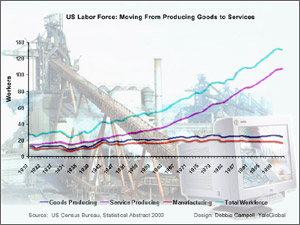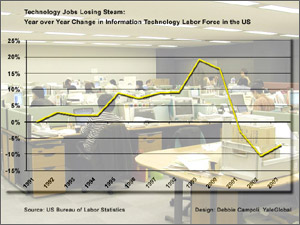Outsourcing Debate - Part II
Outsourcing Debate - Part II

NEW HAVEN: A new specter is haunting America's political landscape - the flight of white-collar jobs to foreign countries. As educated voters grow worried about unemployment, US politicians are adopting protectionist rhetoric. However, the outsourcing of office work to developing countries raises fundamental questions about the world economic system that are unlikely to be answered this election season.
Because the government does not collect data on outsourcing, nobody knows for sure how many jobs have gone offshore. Private IT research firm Forrester estimates that some 400,000 American service jobs have been moved overseas since 2000. This figure may not appear so serious in a country with 130 million workers, but it is the possibility of future job loss that has politicians spooked. Forrester estimates that 3.3 million American service jobs will be offshored by 2015. Add to that the rosy forecasts about job growth in India and one has the makings of a serious problem. A report by McKinsey predicted that by 2008 IT services and back-office work in India will grow fivefold, employing four million people. Not surprisingly, a plethora of anti-outsourcing legislation has been introduced into state legislatures, and the US Senate is considering banning the outsourcing of government-funded projects.
Voter anger today is not unlike that of past decades when manufacturing jobs left America for cheaper shores. (See Chart 1) Then, some protests were quelled by the possibility of moving "up the economic ladder" as the US transitioned to a service economy. Now, however, the upper end of that very growing sector of US economy is coming under threat. Unlike in the nineties when a period of mass layoffs was more than offset by the net creation of 22 million new jobs, the current job creation machine is sluggish.

One can see this downturn as cyclical and dismiss the rising concern as election year fever. Some analysts, however, worry that more is at stake. Blue-collar workers, long wary of outsourcing, have now been joined by programmers, engineers and office workers - a group with much greater political clout. And the media is covering the story more than ever before. One CNN program has begun campaigning against outsourcing, compiling a web-based list of companies (so far totaling 326) that it accuses of "exporting America" by "either sending American jobs overseas, or choosing to employ cheap overseas labor, instead of American workers."
Democratic Party front runner Senator John Kerry has begun calling such firms "Benedict Arnold companies" after the most despised traitor of the American war of independence. This week Kerry stepped up the pressure: "Companies will no longer be able to surprise their workers with a pink slip instead of a pay check; they will be required to give workers three months notice if their jobs are being exported offshore." If he wins the presidency, Kerry would require the Labor Department to compile statistics of jobs sent offshore and report them on an annual basis to Congress.

In a way, the latest outsourcing phase is simply a result of the Internet bubble. Thousands of kilometers of fiber optic cable and high bandwidth connections laid during the boom years have united much of the world in high-speed connectivity. Relentless growth in storage capacity and high-speed transmission (digital scanning is currently at 200 pages a minute) has meant that anything can be digitized and sent anywhere for processing.
This new and cheap capacity has emerged at a time when corporations, emerging from recession, are desperate for cost-cutting measures to boost profits. With manufacturing transferred overseas, high-speed imaging and communication technology can help cut costs even further - in software applications, data processing, accounting, and customer service. (See Chart 2) Many large US corporations have become "virtual" manufacturers. Although their product design and marketing is done in the US, the actual production work is carried out in lower cost locations like China or Mexico.

Countries like India have leapfrogged into the 21st century by setting up high-speed networks, effectively turning their cyberspace into virtual office space for the West. Now an employee sitting in Chennai can examine the image of a medical insurance claim on his computer screen and fill in the form for processing. As Andrew Grove, the CEO of Intel Corporation, said in a speech, "From a technical and productivity standpoint, the engineer sitting 6,000 miles away might as well be in the next cubicle and on the local area network." It is that invisible worker, ready to work for a tenth of the average US salary, that is beginning to scare the American middle class.
In addition to fast-developing infrastructure, there has also been a sharp rise in the number of English-speaking engineers, accountants, and business students graduating from Indian universities. For many of them, call centers are a first step into the job market, and they are happy to earn a fraction of what their American counterparts may be getting. It is not surprising that companies - big and small - have rushed into India's cyber-office space.
Ensuing job losses appear more unnerving for three additional reasons. Many of those laid off have been at the peak of their careers in the service sector. Illinois congressman Don Manzullo (R), who chairs the House Committee on Small Business, makes the point bluntly: "What do you tell the Ph.D., or professional engineer, or architect, or accountant, or computer scientist to do next? Where do you tell them to go?"
There is a gnawing fear that given the cost advantages and unlimited supply of competent workers, jobs now leaving the US may not come back. The savings that corporations achieve through outsourcing will reduce consumer prices and raise shareholder profits, but without necessarily creating any jobs at home. The classic solution to the problem of job loss created by technology has been to promote education and retraining programs. But if an unlimited supply of workers with similar skills is available at the end of a broadband wire for a tenth of the salary, the textbook economics remedy may not work. There will obviously be many office jobs requiring direct client or team contact, but those jobs that can be done in isolation are increasingly up for grabs in a global labor market.

Tough immigration policy has so far been effective in keeping millions of would-be job seekers from the developing world out of the developed world labor market. But the challenge of a global, virtual labor force will require new global development strategies. Building protectionist walls may be attractive as a quick election-year fix, but post-industrial age problems cannot be addressed by solutions devised for another era. It is time to think of a whole new approach in the US to corporate tax, health and employment policies that will make its workers more competitive in the global marketplace. Additionally, the US should concentrate on its comparative advantage in technology invention and radical innovation, creating whole new industries and spheres of jobs for Americans in the future. In the long run, however, developing countries must grow, pushing up wages and increasing their demand for US products. Higher wages will reduce low-cost countries' comparative advantage in labor, and increased demand will create more jobs for the US export sector.
Nayan Chanda is Editor of YaleGlobal Online and Director of Publications at the Yale Center for the Study of Globalization.